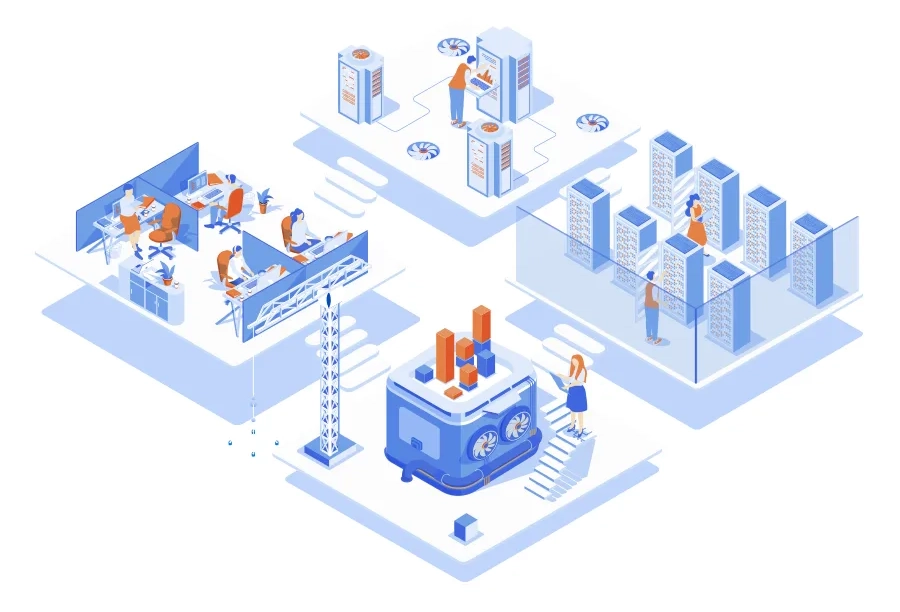
In our previous series, “IDC Watch” series, we shared forward-thinking perspectives and solutions for high-density data centers during the golden age of computing power, covering every stage of construction to operation, and maintenance. Moving forward ,our new series “TCO Talks” will focus on how large enterprises can optimize the total cost of ownership (TCO) in data centers, enhance business resilience, and tackle the dual challenges of massive data storage and complex computing in the rapidly evolving AIGC era. Throughout this series, we will spotlight industry trends and market dynamics, and share Chayora’s innovative solutions. We will also demonstrate how data centers can empower enterprises to reduce costs, boost efficiency, and secure competitive edge across all stages of deployment, operation, and maintenance.
Driven by the rapid development of AIGC, computing power has become a critical resource and a cornerstone of competitiveness in digital transformation and innovation. As the digital economy enters a new phase of development, data centers have become the essential foundation for powering enterprise computing. In this new era, their efficiency and cost-effectiveness are key to maintaining a competitive edge.
For large enterprises handling vast amounts of data and complex computing demands, the demand for more efficient and competitive data center solutions is growing. As a result, finding ways to reduce costs while improving data center performance has become a key challenge for driving business growth.
Opportunities and Challenges of Data Center TCOin the AIGC Era
What is Data Center TCO? TCO, or Total Cost of Ownership, is a comprehensive financial assessment used to evaluate all costs associated with assets such as equipment, systems, and services throughout their entire lifecycle. In general, traditional TCO includes both one-time capital expenditures and ongoing operational costs. Capital expenditures include upfront costs that are depreciated over time, such as data center construction and equipment procurement. Operational costs, on the other hand, refer to monthly expenses once the equipment is in use, including electricity bills, maintenance, upgrades, and salaries for on-site personnel.
In the AIGC era, the rapid deployment and flexible scaling of data centers have a significant impact on TCO. That is because time plays a crucial role in an enterprise’s ability to quickly adapt to market dynamics and accelerate digital transformation. According to an IDC report, "Given the high cost of local training for large models, enterprises are increasingly relying on AI-ready data center facilities and generative AI server clusters, which helps reduce deployment times and long-term investment costs for facilities." As a result, fast-deploying data centers can accelerate time-to-market, enabling enterprises to focus more resources and efforts on core business activities. This, in turn, enhances operational efficiency and strengthens market competitiveness.
However, TCO innovation in the AIGC era faces significant challenges. The rapid advancement of AI, cloud services, and other technologies has led to a surge in demand for computing power. As a result, data centers must handle much more and increasingly complex data processing tasks and expanded operation and maintenance requirements, driving up both construction and operational costs.
Currently, high-density deployments, the adoption of liquid cooling technologies, and the rising demand for high-performance computing and data storage are all exerting a profound impact on TCO. Data centers must optimize energy efficiency and reduce overall energy consumption while maintaining high computing power. This is crucial in addressing the dual challenges of computing power and energy efficiency in the AIGC era.
Why is Data Center TCOSo crucial for business ?
To begin, it's important to consider the specific needs and challenges faced by enterprises across different industries. For these organizations, developing a clear understanding of the costs associated with planning, construction, and ongoing operation and maintenance of data centers is critical. High costs, complexity, and other barriers often discourage enterprises from pursuing this route. Additionally, the investments required for planning, design, construction, and operation can present significant challenges.
The growing demand for data centers and the associated challenges in construction, operation, and maintenance further highlight the importance of optimizing data center TCO for business growth. Effectively reducing TCO and improving operational efficiency enables enterprises to better allocate resources and lower operational costs, which is essential for driving rapid innovation in businesses. For enterprises requiring Build-To-Suit data centers, it is crucial to accurately predict and measure data center TCO. This allows them to better calculate costs when selecting more suitable data center solutions.
The data center industry is evolving toward higher density, greater intelligence, and enhanced high efficiency. As a key part of AI infrastructure, these emerging trends not only drive the growth of the computing power sector and related industries, but also foster technological innovation within the IDC industry.
More enterprises are now focusing on innovating and improving the TCO of their data centers. Across industries, enterprises are seeking data centers that can be rapidly deployed while maintaining safety and reliability. They are also focusing on controlling depreciation and operational costs to maximize return on investment. At the same time, reducing data center TCO has become a priority. These efforts not only contribute to cost reduction and efficiency improvement, but also enhance customer satisfaction and overall user experience.
How Can Data Centers Reduce TCO and Support Efficient Transformation?
In the process of innovation within the enterprise, reducing data center TCO requires collaboration across multiple dimensions, including data center design, construction, and operational management. To meet the growing demand for high density and flexibility in the industry, the IDC industry should provide more diverse, customized, efficient, and flexible solutions to help enterprises manage cost while maintaining stability.
Given evolving needs of different industries, Chayora's hyperscale Build-To-Suit data center solutions serves as a key enabler for rapid digital transformation in the industry. Ingenuity, Chayora's high-density data center solution, helps enterprises create flexible, tailored smart computing centers that effectively support the growing demands of AI applications and high-performance computing workloads.
Chayora’s hyperscale Build-To-Suit data center services are driven by the specific business needs of each customer. By focusing on practical applications and requirements, these services minimize waste and reduce deployment and operational costs. At the same time, they give enterprises the flexibility and intelligence needed for sustainable innovation and growth.
Furthermore, through the strategic deployment of air- and liquid-cooling technologies, as well as innovative electromechanical and HVAC designs, Chayora significantly enhances equipment operation and energy efficiency. This approach ensures that data centers can better meet the diverse business needs of customers across various scenarios.
To effectively address challenges such as rising IT costs driven by increased computing power demands, Chayora’s hyperscale Build-To-Suit data center solutions not only help customers control costs but also significantly reduce time-related expenses. With rapid deployment strategies, enterprises can quickly launch new services and accelerate their time-to-market. This means enterprises can realize faster returns on investment and gain a competitive edge in a fast-growing market. Chayora’s solutions offer a flexible and reliable service model that optimizes both cost-effectiveness and operational efficiency, ensuring enterprises secure a competitive advantage in terms of both capital investment and time.
In summary, it is clear that digital transformation and business innovation are inherently dependent on the support and empowerment provided by data centers. With the enhancement of computing power, data empowerment, and intelligent integration, the sustainable development of data centers is enabling more enterprises to achieve digital innovation. In the face of transformation needs from different industries, how can enterprises further reduce TCO? We will explore this topic further in the next article. Stay tuned.
1302, 13/F, Spaces Sun House, 90 Connaught Road Central, Sheung Wan, Hong Kong
+852 3653 5268
RM01-06,Level 24 China World Trade Center Office 2 No.1 Jianguomenwai Avenue
Chaoyang District
Beijing, China, 100004
RM116, Level 15 Yuesheng Mansion No.1 Wuning Road South Jing'An District
Shanghai, China, 200042
